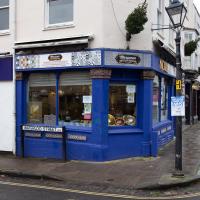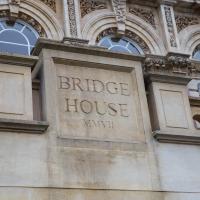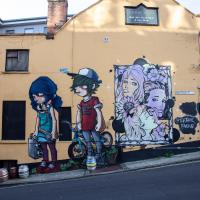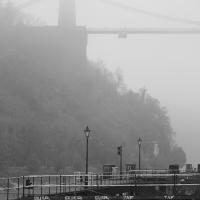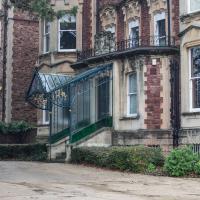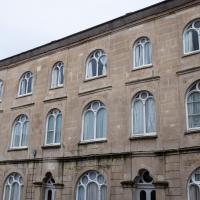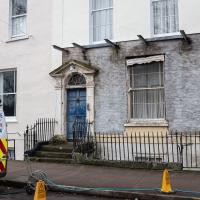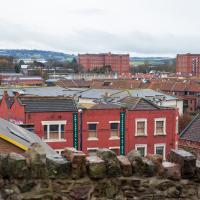Tagged: city
I have no idea how anyone managed to smack this street furniture so hard, or what direction they came from to do it. It's a pretty straight 30mph road right there, and this is only one side of the dual carriageway. Never seen so much as a near-miss there.
And Back Down the Hill from the Flu Jab
21 Nov 2020
This is my return from getting my annual flu jab at Christ Church, as explained in more detail in my wander up the hill.
I don't think this is exactly a public right of way. But I started so I tried to finish without getting the police called on me by worried residents
I do love this terrace. The mansard roofs, the grand central house, the ornamentation, the porches. It's all rather grand.
encaustic | ɛnˈkɔːstɪk |
adjective
(in painting and ceramics) decorated by burning in colours as an inlay, especially using coloured clays or pigments mixed with hot wax.
It's a great name for a shop and a striking colour to boot. Excellent marketing, and closer to me than my traditional haunt of Kitchens Cookshop at the top of Whiteladies Road. Maybe the next time I need a utensil I'll give them a try. I think the young woman in the shop spotted me taking the snap.
For some reason I'm reminded of the time I was browsing the sadly-now-gone Avon Books (which used to occupy 4a Waterloo Street, next to Kitchen Artillery, which occupies 4b) and found that all the books on subjects like this were collected into a section labelled "Mumbo Jumbo"
Up for the flu jab
21 Nov 2020
A trip up the hill to get my winter flu jab. I'm not sure I really needed it this year, what with avoiding Covid—I haven't had so much as a sniffle in more than a year—but seeing as they offered... Instead of the doctor's surgery on Pembroke Road, they'd taken over Christ Church, presumably to give more room and ventilation for the necessary social distancing at the moment. As usual, it was their typically efficient operation, and I was in and out in about three minutes.
On the way there and back I snapped as much as I could, but I wanted to be home in time for the first online Times Crossword Championship. As it turned out, I needn't have bothered, as the technology at the Times couldn't keep up with the demand from competitors, and their system just collapsed under the weight of page-views. They tried again the day after, and it collapsed just as badly. Maybe next year...
This wander is split into two parts, as I turned my tech off to go into Christ Church for my jab. The walk home can be found over here.
This was meant to be the day of the first online Times Cryptic Crossword Championship. Sadly the Times's web servers let them down, so the event was a washout, and I dashed back from my flu jab to take part for no good reason, as it turned out.
The destination for my wander today. My doctor's surgery branched out into Christ Church to give them more room for socially-distanced administering of the flu jab. Fast and efficient as usual.
Avoiding the Accounts
26 Nov 2020
I took the day off my day job to do my accounts—or at least do enough bookkeeping to send them to my accountant. I hate doing the books. I woke up late, tired and with a headache and decided to bunk off for a walk around Cliftonwood, Clifton Village and Clifton instead, taking in a couple of good coffees along the way. Thanks, Foliage Café, and Twelve for the flat whites.
From what I've worked out so far, the use of St Vincent's name around so much of Bristol, especially Hotwells and Clifton, dervies from the ancient hermitage and chapel dedicated to St Vincent of Saragossa, which (possibly) was in Ghyston’s Cave, the cave in the rock face now accessible through a tunnel from the observatory, but at the time only by a perilous cliff climb (which I can only presume is what made it so appropriate for a hermitage.)
Why St Vincent of Saragossa? Anthony Adolph says:
It should be explained that the connection of Bristol with the Iberian wine trade led, in the Middle Ages, to Bristol’s importing of the cult of Lisbon’s patron saint, Vincent.
I have done very little real research on this so far, though, so don't take my word for any of it. I am not a historian, etc.
The Hillsborough Flats are a lot prettier from the back than their frontage on the Hotwell Road suggests, I think.
The Long Lunchtime at the End of the World
27 Nov 2020
I took an extra-long break at lunchtime today as I'd taken the day off my normal day-job to do the accounts for my previous side-job, which is still generating paperwork, though not much in the way of money. This took me through some undiscovered bits of Cliftonwood, including Worlds End Lane, which unexpectedly leads to White Hart Steps. That's certainly not where I expected the end of the world to lead to...
I don't know much about architecture, but I know I'm underwhelmed by whatever's going on here.
A long ramble, starting with trying to find the Hot Well of Hotwells and leading up the side of the Avon Gorge to the Downs and then through Clifton for coffee.
Ten O'Clock Shop and Can't Dance Coffee
30 Nov 2020
I had to return a faulty AirPod Pro to Apple (there's a first-world problem!) so I just took a quick trip up the hill to the nearest UPS drop-off point, The Ten O'Clock Shop, which is famously open until 11pm. Unfortunately it's a fairly cramped little place and neither of the staff were wearing masks, so I made it a very quick drop indeed and got out of there as quickly as I could.
I grabbed a quick coffee from Can't Dance, a stall that's—as of yesterday—in a tiny converted cargo container on the edge of Victoria Square; up until this week they were running from a little trike parked in the same place. Hopefully the new premises will let them see out the winter without worrying quite so much about the weather.
I tried to fit in a few extra streets from the surrounding area on my there and back, but that was basically my wander today: a quick little shopping trip.
Mint on the left, Rosemarino on the corner ahead, where the old York Cafe used to be, serving a full English for £1, back in the day.
Looking down onto Hanover Lane, which I often use as a cut-through when heading for the Triangle. In the Beforetimes I'd often walk between Waitrose and home via that route.
I've always liked the windows along here. From what I can remember, the little circles at the top can be opened, too, as well as the larger main windows as you'd expect. I could be wrong, though. Not much call to open the windows on a cold day like today.
It's a pretty impressive tree, as is the fact that a giant building like Manor Hall is so unobtrusive that you could wander past it at this level without ever paying it much attention. I did, for years.
Got your work cut out making that window look good. They were actually working around the corner.
Fruitless Coffee Excursion
01 Dec 2020
Unfortunately by the time I got to Greville Smyth Park I was already about halfway through my lunch-hour, and the queue was too long to wait to actually get a coffee. Is that a fruitless excursion? Presumably a coffee bean is technically a fruit...
This kind of vague musing was sadly overshadowed by my delay at Ashton Avenue Bridge on the way back, where someone—hopefully still a someone, rather than a body—was being stretchered up the bank of the river, presumably having just been rescued from the water. As I made my way home the long way around, avoiding the cordoned-off area at the back of the CREATE centre and its car park, I saw an ambulance haring across the Plimsoll Bridge, siren running, presumably on its way to the BRI. I'd like to think that was a good sign.
One thing I didn't know existed until this moment: Avon Fire & Rescue Service's specialist Animal and Water Rescue Units. They "...carry specialist equipment such as inflatable rescue paths, mud lances, animal rescue strops and harnesses, and a winch..." and "...have attended a range of incidents including the rescue of a woman from a car trapped in flood water and a donkey trapped in mud".
I don't know why there were here today, but that doesn't look like an animal on that stretcher/sled thingy. It looks to me rather like they're retrieving a body from the water. The police were in attendance, too, and the whole area was cordoned off.
I know from talking to the ferry crews that rather more bodies are pulled from the harbour every year than you'd imagine from any newspaper reports you might see. I'm guessing the same goes for the river.
Cliftonwood and a Secret Garden
03 Dec 2020
I love the isolation of Cliftonwood -- the geography of it, with its solid boundary of Clifton Vale to the west and Jacob's Wells Road to the east mean that you tend not to be in Cliftonwood unless you've got a reason to be there. It's not a cut-through to anywhere, at least not from side-to-side, and you can only really exit to the south on foot.
I sense that I'd be happy living in Cliftonwood -- like my bit of Hotwells, it's a quiet little area with a sort of quirky feel to it. Plus it contributes the colourful houses that are the backdrop of about half of all Bristol postcards ever made :)
I found the "secret" garden especially interesting, just for the fact that it really does feel quite secret, despite the obvious name on the gate. I've lived a half-mile from it for twenty years and I don't think I've ever noticed it before, despite exploring the area a few times.
Weird Bristol posted this picture and I don't know the source, I'm afraid. It shows the fountain at Cumberland Piazza, long-since fallen into disuse, filled with soil and planted with trees.
I did once have a beer in the garden when it was The Spring Gardens. It became La Demi Lune for a while, from what I remember, then shut down. Having just Googled it, before it was the Spring Gardens apparently it was "Durty Nelly's"!
From what I can see on Street View it's just flats now, but I can't be sure without going and having a proper look around the front. Maybe next time...
Strangers' Burial Ground
04 Dec 2020
I tried to find the Strangers' Burial Ground the last time was up in Clifton, but I'd not realised that Lower Clifton Hill continues further on after the turning with Constitution Hill. Sadly it was chained shut, but it still looks beautifully-maintained, perhaps by the same man referenced by this story from John Hodgson, which helped me find it. Apparently Thomas Beddoes is buried here.
I take a snap of the Clifton Club virtually every time I pass. Perhaps it's having read too much Jeeves & Wooster; I fancy belonging to a private members' club. But then, on reflection, I'm perhaps with Groucho Marx on that one.
Only been in a couple of times over the years. I like the way it's got a back entrace from the Arcade, and I seem to remember the beer was varied and well-kept.




